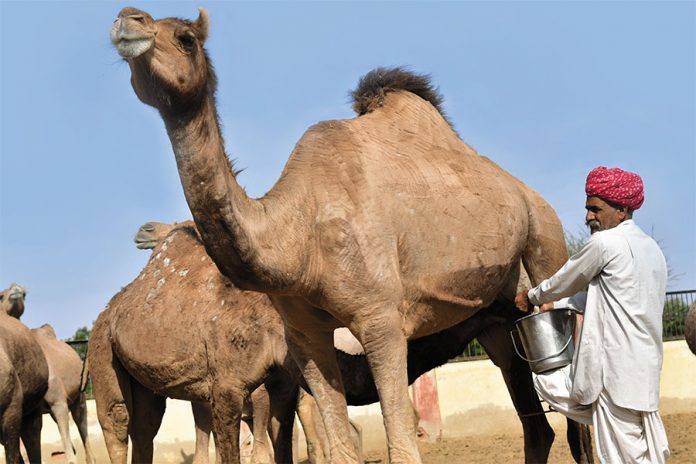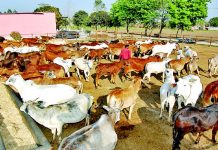
This article is written by Ms. Somya Jain, from Vivekananda Institute of Professional Studies. The article enumerates the relevance and effects of the Camel Prohibition Act in Rajasthan and the growing concern of the declining camel population. It further establishes the ground realities when the applicability of the Act is in question.
Table of Contents
Introduction
Camels have been one of the major sources for the survival of many indigenous communities living in the state of Rajasthan. For generations, these communities have been rearing different breeds of the camel for fulfilling the basic necessities of their lives. But in recent times, camel species have plummeted at an alarming rate which is a matter of concern for not only the breed-rearing communities but also for environmentalists and other stakeholders. According to the 20th livestock census, released in 2019, there are some 2.5 lakh camels, down from the 4 lakh counted during the previous census in 2012. The situation called for immediate action by the government.
Considering the declining rate of camels in Rajasthan, the state cabinet introduced the Rajasthan Camel (Prohibition of Slaughter and Regulation of Temporary Migration or Export) Act, 2015. The Act sought to exterminate the export of camels outside the state territory for the purposes relating to slaughter. For any other reason, if the breeders wanted to export camels, it could not be undertaken without the approval of recognized authorities. Although the act was initiated with a positive approach by the legislators, it was refuted by breeding communities extensively. Rather than establishing the legislation for the breeders, the Act agitated them as the provisions were detrimental to their livelihoods. Questions were raised whether the law empowers them or enslaves them to the pertitude act of the government.
Background of the Act
Rajasthan is the home to many camel breeding communities, especially for Raikas and Rabari communities. For centuries, these communities were employed in the profession of rearing camels. With the development of the concept of animal husbandry, they started exploring their options to utilize camels in the best way possible. With the paradigm shift from merely utilizing them as resources in the fields to milking them, using their products such as dhurries from wool, paper products with dung, the breeders have come a long way to ramp up their production capacity.
But it was demonstrated that such activities require fundings and investments without which the rearing of camels would be next to impossible. Further, it was noticed that the population of the camels was decreasing at a faster pace due to numerous reasons, one of them being exporting the camels for slaughter or selling the male dromedaries for meat. Due to the reduction in the population of camels, the breeders were desperate to divest themselves from their herds.
In pursuance of these reasons, the Rajasthan Government took the initiative to establish the Rajasthan Camel (Prohibition of Slaughter and Regulation of Temporary Migration or Export) Act in 2015. On 30th June 2014, the camel was given recognition as the state animal of Rajasthan.
Reasons for the decline in the population of camels
With the growing advent of the pastoral communities regarding the depreciating population of camels, several reasons were noted. Factors such as the shrinking of grazing areas, difficulties in providing veterinary care, and the absence of economic returns have added to the slump in the dwindling population of camels.
Shrinking of grazing areas
One of the foremost reasons for the plunging population of camels is the shrinking of grazing areas. Some of the reasons for it are:
Enclosures by the forest department and protected area
Historically speaking, the camel breeders followed the practice of grazing their herd in the forest land set aside by rulers for camels and farmland for grazing. But over the years, these lands have become inaccessible. There have been increasing restrictions by the forest department for grazing pastures. Earlier, the camels were allowed to stay in the forested areas for about 2 months but this act has been disallowed by the authorities. Kumbhalgarh, which is the major forested area, has eliminated grazing opportunities for camels. According to the forest authorities, the forest has been reserving the acreage of the forest land and wildlife. This removes the possibility of pasture lands.
Under the Schedule Tribe and Other Forest Dwellers (Recognition of Forest Rights) Act (FRA) 2006, there is a provision for recognizing grazing rights. However, no Community Forest Rights titles had been given to camel breeders.
Further, with the developed technology in play, the resources of camels have been undermined which renders them inefficacious. Due to the intensive use of fertilizers and other enhanced techniques in the arena of agriculture, the farmers have negated the utility of camel urine and feces acting as nourishment for the agricultural land.
Tube wells and irrigation
With the commencement of the green revolution, the farmers undertook irrigation activities by way of establishing tube wells. The water supply through these tube wells lasts only 6-7 years after which farmers shift to another land. The abandonment of the land without any vegetation cover leaves the land arid and inefficient for grazing.
Urban development
With the growing urbanization, the deserted land has been encroached on by mankind rather than utilizing for pastures and grazing purposes. This has further led to the shrinking of grazing fields. Further, the construction of the Indira Gandhi Canal has prompted a great threat to the migration patterns of the camels and they were forced to retrace their steps. Such actions discourage the breeders to continue with rearing activities.
Several diseases
Another reason for the reduction in the population of camels is due to lack of proper veterinary care. Camels majorly suffer from skin diseases including mange, which though not lethal if left untreated can be noxious. Further, the drugs for these diseases are not widely available and are overpriced which further adds to the hardships for the breeders. The Department of Animal Husbandry of the Government of Rajasthan has set up 7,897 Veterinary Institutions comprising polyclinics, veterinary hospitals, veterinary dispensaries, sub-centers, and district mobile veterinary units across the state. But these institutions are not far-reaching and do not provide their services to all the villages.
Lack of economic returns
Preceding years have been extremely difficult for the breeders as rearing camels have cost them their life savings. It is observed that the sustenance of the herd requires a large amount of investment. Further, with the developed technology in existence, it added to the plight of the breeders as utilizing camels for varied purposes has reduced to a great extent.
The Milk industry, being one of the largest industries in India, has not yet explored the option of using camel milk for producing milk products or other essential commodities. There is no organized market for camel milk and this being low-fat milk, it only costs Rs. 18-20 per liter. Added to this, the cost of drugs for the camels is very high which makes it impossible for the breeders to afford the same.
Another factor can be the growing awareness of veganism among people. Society is slowly moving towards the concept of veganism which renders the breeders to not sell camels for meat. This further adds to their cost.
Objectives of the Act
The “Prohibition Act”, was proposed with the objective to curb the diminishing ratio of the camel breed by prohibiting the export of camel mainly for the purpose of slaughter. The Act focuses on mitigating the reasons behind the dwindling population and addressing the factors by reasonable solutions. It further aimed at proliferating their breed by creating demand within the state.
Effects of the Act
The 2015 Act brought about more criticism than appreciation. One of the major concerns highlighted by the Lok-hit Pashu Palak Sansthan, an animal body of 8,000 breeders, was that the state government banned the export of camels outside the territory of Rajasthan for the purpose of slaughter. Further, the act enumerated that temporary migration in times of drought or famines or for fairs, camels can be migrated to other regions with the prior approval of the authorities. Without the permission of competent authority, camels are prohibited to be exported from Rajasthan, making the transporter guilty of abetment and liable for punishment.
It was contended by the breeders that the Act instead of benefiting them has brought negative effects as it led to decimating the camel population from 3,00,000 in 2012 to 2,00,000 presently. State border migrations of camels were necessary for providing milk to other states, which have now been prohibited without fulfilling the required conditions. As per the Lok-hit Pashu Sansthan, camels were also being exported to Arab countries due to high demand and a ban on export from the state has crashed the cost of camels from Rs. 30,000 to Rs. 2500 only. Further, there is a demand for camels in Punjab and Haryana for ploughing fields but they avoid buying them because of extensive paperwork.
The restrictions underlying the Act and by the restricted entry in the forested land for grazing their herd, water diversion to agriculture, and the replacement of camels with farming technology, have contributed to extreme hardships for breeders forcing them to give up their livelihoods.
As far as the counterproductivity of camels is concerned, they can be used for milking. But the state in this industry remains unorganized and the government has been unresponsive in this matter. Camel milk which has a testament for therapeutic benefits has not been given the much-needed importance. Rajasthan has 3 major camel milk collection centers in Bhiwadi, Chittor, and Udaipur. Even after setting up these centers, the Rajasthan Dairy Cooperative does not accept camel milk.
With the rudimentary approach of the Act, the breeders will have a lifelong struggle to find a stable livelihood pertaining to rearing camels. Prior to the initiation of the Act, the government failed to take the suggestions of the breeders who were devastated by it.
Steps taken by the government
Along with the establishment of the Prohibition Act of 2015, the government in 2016 launched a scheme called the Camel Development Scheme (CDS) under Ushtra Vikas Yojana. This scheme provided a means of livelihood to the breeders by extending incentives of Rs. 10,000 for every camel calf born. The payment is done by way for three installments- Rs 3,000 at the time of birth; Rs 3,000 at nine-month-old; and Rs 4,000 once the calf crosses 18 months. As per the government data, around 30,000 breeders benefited from the scheme over a period of four years. But the ground reality states differently. According to the community of breeders, most of them only received one installment in 2016-17 and nothing after that. The state discontinued the scheme in 2018 because permission from the central government had lapsed.
In the recent budget session of the Rajasthan Assembly, questions were raised regarding the efforts taken by the ruling party in this matter. Animal Husbandry Minister Lalchand Kataria said his department had constituted a committee to look into the matter, and he himself was heading the committee. It was admitted by him that camels have become “irrelevant” in recent times, and farmers are abandoning them in jungles. But the aggrieved breeders and other stakeholders wrote a letter to Chief Minister Ashok Gehlot in November 2020 to provide solutions for the same. A meeting was held, comprising various stakeholders including the director of ICAR-National Research Centre on Camel, NGOs, breeders, and officials from the National Bank for Agriculture and Rural Development (NABARD). Several concerns were raised against the validity of the Rajasthan Camel (Prohibition of Slaughter and Regulation of Temporary Migration or Export) Act of 2015.
The government as a result planned to start the Ushtra Vikas Yojana again to not only combat the declining population of the camels but to also provide livelihood means to the breeders. Further, National Research Centre on Camel (NRCC) in Bikaner has taken up the initiative to produce products from camel milk to support the breeders. NRCC has established the finding that camel milk has several benefits in the treatment of Type 1 diabetes, hypertension, tuberculosis, and even autism. In 2016, the Food Safety and Standards Authority of India (FSSAI) approved the sale and trade of camel milk as a food item with specific standards. But the fact cannot be denied that the Act lacks provisions for the betterment of the breeders. Rather this legislation works parallel to the interest of their community which adversely affects livelihoods.
Recommendations
The breeders and the Rajasthan government have undertaken to formulate some recommendations which will be implemented by the competent authority. Some of the recommendations include:
Secure, establish, maintain camel grazing areas
It has been observed that due to curtailing of the customary grazing areas, camel breed has been chronically affected which led to a decline in their reproductive state. In order to provide a proper grazing area for the camels, the breeders should be consulted and relevant areas should be marked out for the same. Although, this should not hamper the rights of other grazing animals.
Establish a market for camel milk
Camel breeders have no source of income with the development in place. It becomes essential to provide counterproductive uses of camels. Milking of camels is one such method that could be a great source of income provided that it is recognized in India. Steps could be taken to subsidize the private sector to enter into dairy marketing. Further, advertising campaigns should be initiated to promote camel milk. The separate collection and payment systems can also be introduced.
Promoting camel milk
The utility of camel milk has not been denied as it enumerates several therapeutic benefits in different kinds of diseases such as autism and diabetes. What it lacks is awareness among the people which can be created through promotion activities. Firstly, it should be promoted as a health product, recapitulating the underlying benefits which the product carries. Secondly, it should be provided for midday meals to students along with women and TB patients to increase further awareness among society. Lastly, Ayurvedic camel milk should be promoted amongst tourists visiting India and Rajasthan that would increase our international reach.
Invest in value addition to camel raw materials
Research and training institutes should be incentivized to produce technologies and designs for the products made from camel raw products. Design students should be motivated to create products from camel by-products. Lastly, subsidies should be provided to micro-artisans and small enterprises for the production of the same.
Added to these recommendations, the breeders also demanded to remove the ban on the export of camels, though no decision has been taken up by the state government yet in this regard.
Conclusion
The declining percentage of the camels has been worrisome but mere efforts to increase their population by banning their export will not render any benefit. The interests of the breeders should not be neglected as they are the ones who are closely connected with the survival of the species. An integrated system of the desert’s agro-ecosystem and the camel species should be set up otherwise the services of the camel will remain redundant and uneconomical.
Reference
- For the Camels of Rajasthan, a Struggle for Survival – and Relevance – The Wire Science
- Why Rajasthan’s camel protection law is not enough to save its camels (downtoearth.org.in)
- Why Rajasthan’s ban on camel slaughter may actually end up reducing their numbers (scroll.in)
- Rajasthan talks of changing law that hit camel population (downtoearth.org.in)
- After new law, camel breeding hits a hump – Hindustan Times
- Rajasthan law, its modernising villages — why you may find camels only in a zoo in future (theprint.in)
- India’s new camel legislation: protection or relegation? | openDemocracy
LawSikho has created a telegram group for exchanging legal knowledge, referrals, and various opportunities. You can click on this link and join:
 Serato DJ Crack 2025Serato DJ PRO Crack
Serato DJ Crack 2025Serato DJ PRO Crack










 Allow notifications
Allow notifications



